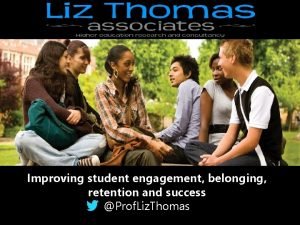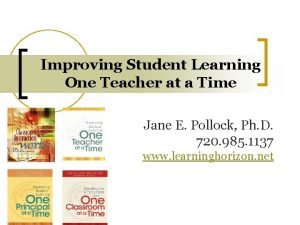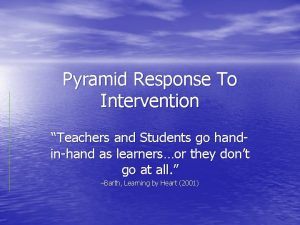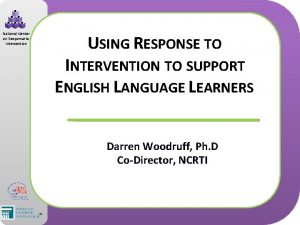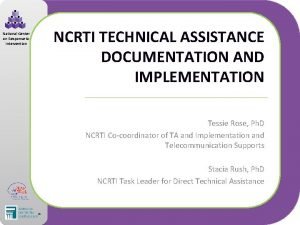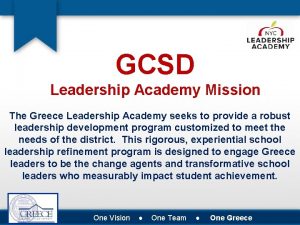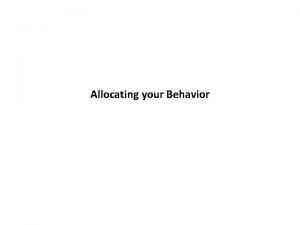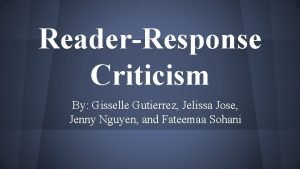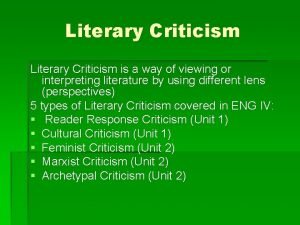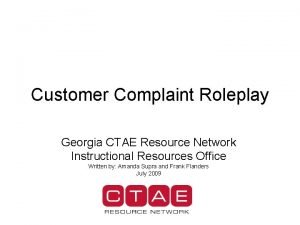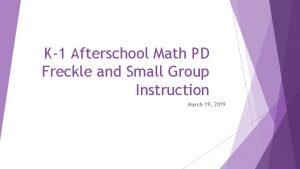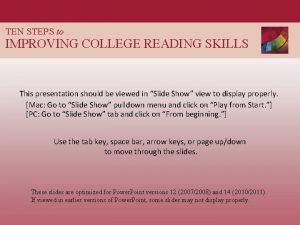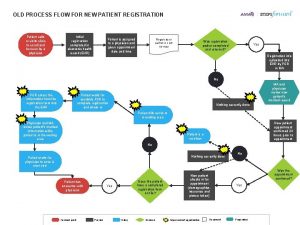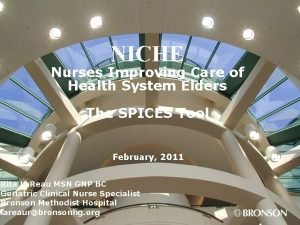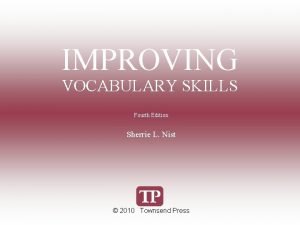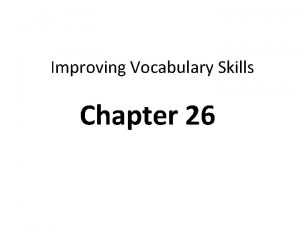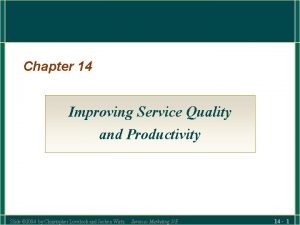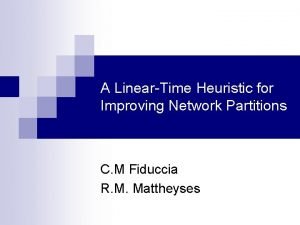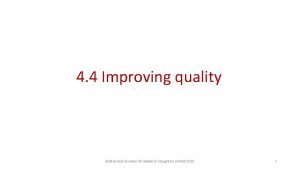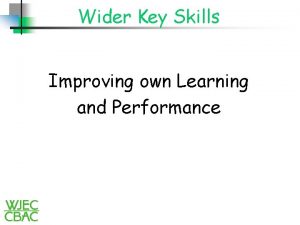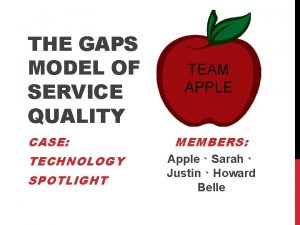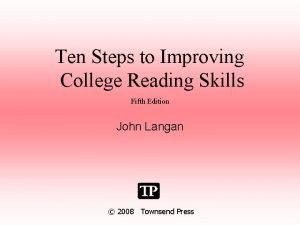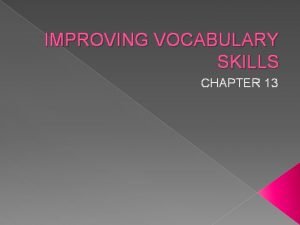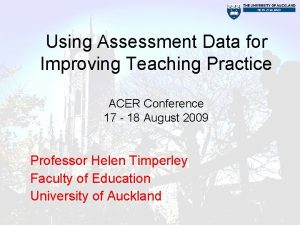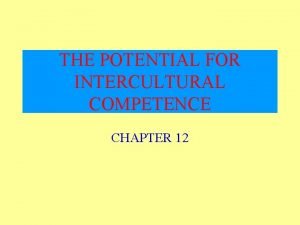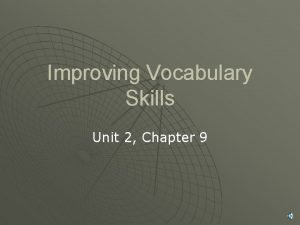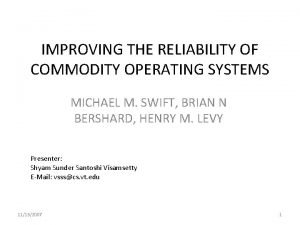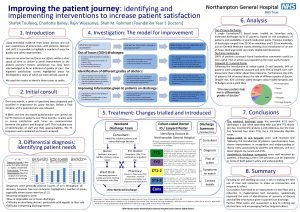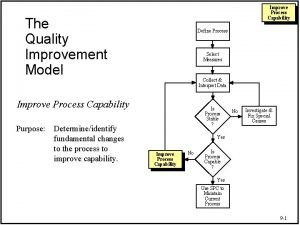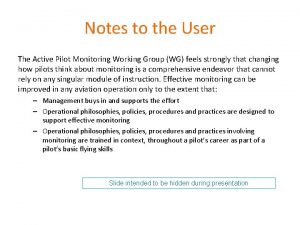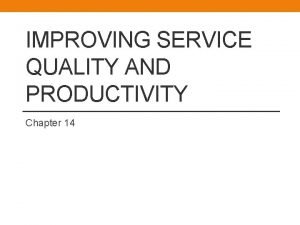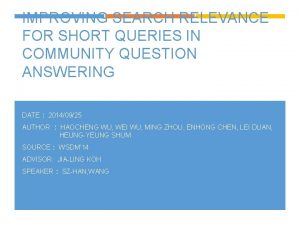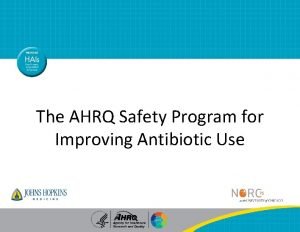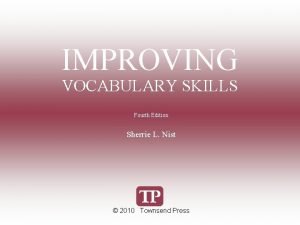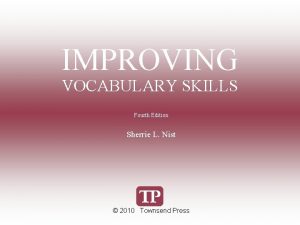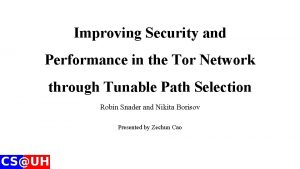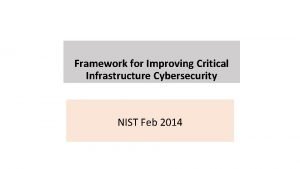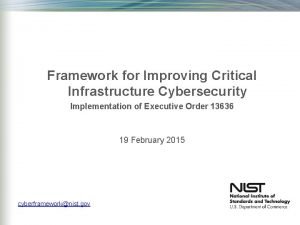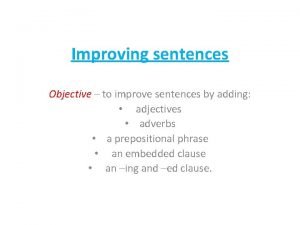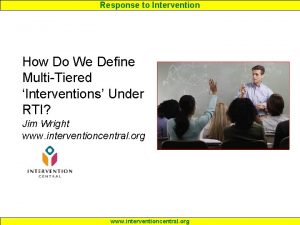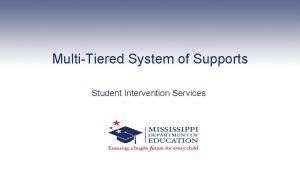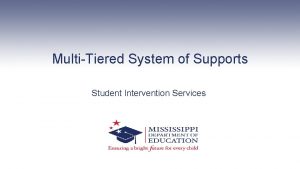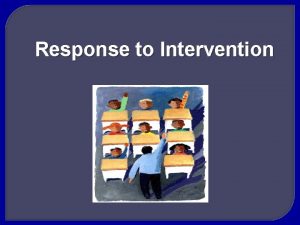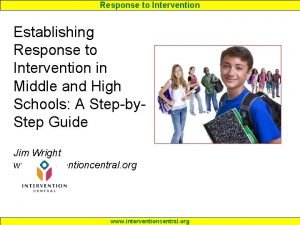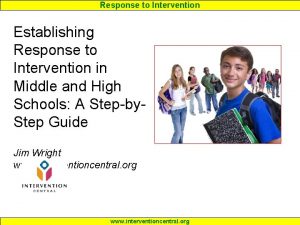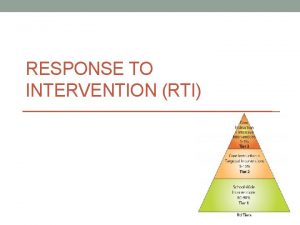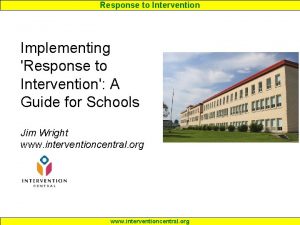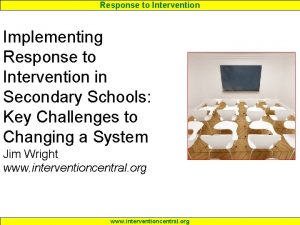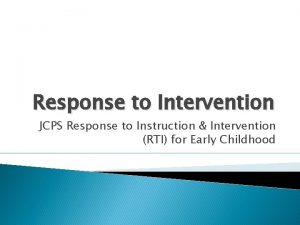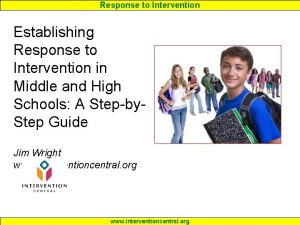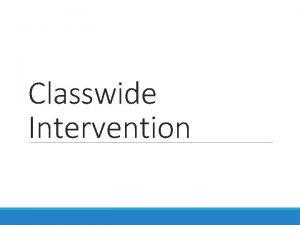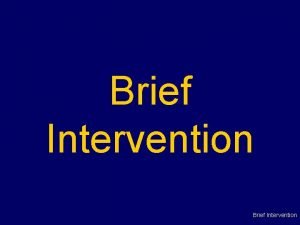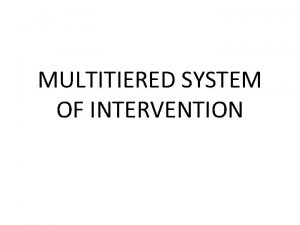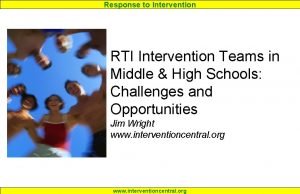Response to Intervention Multitiered Approach to Improving Student







































































- Slides: 71

Response to Intervention Multi-tiered Approach to Improving Student Performance DR. EDWARD AGUILES PRESENTATION OCTOBER 7, 2016

Discussion: Read the quote below: 2 “The quality of a school as a learning community can be measured by how effectively it addresses the needs of struggling students. ” --Wright Do you(2005) agree or disagree with this statement? Why? Source: Wright, J. (2005, Summer). Five interventions that work. NAESP Leadership Compass, 2(4) pp. 1, 6.

5 Key Questions 1. What happens for those students who are reading below the 4 th grade level? 2. What is in place across a school faculty/staff to ensure that students will get the ‘critical’ content in spite of literacy skill? 3. What happens for students who know how to decode but can’t comprehend well? 4. What steps have been taken to ensure that powerful learning strategies are embedded across the curriculum? 5. What happens for students who have language problems?

Response to Intervention: Tiers without Tears

Definition of “Intervention” A change in instructing a student in the areas of learning, behavioral , or speech difficulty to improve performance and achieve adequate progress.

Program vs. Framework Response to Intervention (Rt. I) is not a program, program but a framework for designing and implementing proactive, preventative programming using data.

What is Response to Intervention (RTI)? Response to intervention is a philosophical approach that has been suggested by nearly every pre-referral service model in the past, but only became an explicit model for aligning student progress with appropriate interventions because of the 2004 reauthorization of the Individuals with Disabilities Education Act (IDEIA), in which it clearly stated that pre referral service programs must now actively monitor the response at-risk students have to prescribed interventions.

What Exactly is RTI? RTI is the practice of providing high quality instruction, and interventions matched to the student needs and using learning rate over time and level of performance to make important educational decisions. High quality Instruction/ intervention: Instruction or intervention, matched to the student need that has been demonstrated through scientific research and practice to produce high learning rates for most students.

Rt. I is a Mindset to Recognize Students with Needs Early An emerging approach to the diagnosis of learning disabilities that holds considerable promise A student with academic delays is given one or more research-validated interventions Progress is monitored frequently to see if the interventions are helping the student catch up with his or her peers If student fails to show significant improvement a number of interventions, this failure to “respond to intervention” can be viewed as evidence of an underlying learning disability

What Rt. I Is NOT: 1. It’s Not About SE Eligibility with a new label (e. g. , pre-referral intervention, old teamnew name). 2. It’s Not About SE “Business as Usual” with programs that meet the needs of adults more than students. 3. Expecting GE Teachers to meet the needs of ALL students (180 students-180 different interventions).

Why Rt. I? Research supports the fact that students determined eligible for special services received more support and services for the purpose of accelerating their performance while in general education compared to when they began receiving special services. The delivery of I&RS and special services through an RTI model can make a real difference in improving educational outcomes for students with and without disabilities. No longer needing to use the “Wait to Fail” model – We can catch the students before they fall between the cracks!

Historical Perspective Problems with our traditional system: Ø High percentage of students in special education ◦ Separation of special education from general education (students, staff and resources) ◦ Undocumented benefits of special education ◦ Over-representation of minorities in special education ◦ Ø Three major developments have coalesced to establish RTI as a promising approach: Concerns about the inadequacies of the ability-achievement discrepancy criterion ◦ Special education being used to serve struggling learners who do not have learning disabilities ◦ An abundance of recent research on reading difficulties ◦

Benefits of Rt. I Allows educators to intervene early to meet the needs of struggling learners Maps specific instructional strategies found to benefit a particular student Eliminates Allows the “Wait to Fail” model students to be successful

14 “RTI implementation has clearly focused on elementary grades, with few attempting it on the secondary level…However, school districts will need to decide when and how—rather than if— RTI will begin in their middle schools and high schools. We suggest focusing on elementary schools in the initial phase of implementation, but eventually including secondary schools in practice and throughout the planning process. ” -- Burns & Gibbons (2008) p. 10 Source: Burns, M. K. , & Gibbons, K. A. (2008). Implementing response-to-intervention in elementary and secondary schools: Procedures to assure scientific-based practices. New York: Routledge.

The Purpose of RTI in Secondary Schools: What Students Does It Serve? 15 While the dual use of the RTI model (1) for early identification/remediation of at-risk students and (2) for the classification of children needing special education is adequate for the elementary level, in middle and high school there also significant numbers of students who have a long history of poor school performance yet will probably not quality for special education services. In secondary schools, RTI must expand its mission to help chronically struggling, unmotivated students in a systematic way. In particular, how does RTI manage the needs of the chronically underachieving secondary student who does not (and likely will not) qualify for special education but requires ongoing academic support?

Secondary Students: Unique Challenges… Struggling learners in middle and high school may: Have significant deficits in basic academic skills Lack higher-level problem-solving strategies and concepts Present with issues of school motivation Show social/emotional concerns that interfere with academics Have difficulty with attendance Are often in a process of disengaging from learning even as adults in school expect that those students will move toward being ‘self-managing’ learners… 16

What Students May Need Rt. I at the Secondary Level? Students who do ‘okay’ early on but have problems when expectations change Students who did not get good early intervention Problems with vocabulary ‘accumulate’ Wide range of problems: some still struggle with early skills, others have comprehension difficulties

Key Factors Why I&RS and Special Education was NOT Optimizing Student Outcomes – Practitioner’s Perspective Limited understanding of the RTI and process within I&RS and special education No or limited use of data in screening and referral process No or limited use of data in identifying and targeting skills/behaviors No measurable goals and objectives Misunderstanding of tier one services No or limited coordination of services and service providers No or limited progress monitoring No or limited use of data in progress monitoring

What Are Some Attributes of High Schools That Address the Needs of Struggling Learners? 19 Small schools (i. e. , 400 students or fewer) Well-articulated school mission that guides ‘development of a coherent curriculum’; unified approach to effective instruction across classrooms; and cohesive school culture Strong relationships between staff and students Close monitoring of student performance required for graduation and college eligibility ‘Challenging and coherent instruction’: ‘High school standards, curricula, and textbooks are a mile wide and an inch deep. ’ Relevant, functional ‘real-world’ application of instructional content and learning activities Source: Gates Foundation (n. d. ). High schools for the new millenium: Imagine the possibilities. Retrieved on July 2, 2008, from http: //www. gatesfoundation. org/nr/downloads/ed/edwhitepaper. pdf

Steps to Implement RTI/I&RS Establish buy- In From: Central Administration CST Principals Guidance Teachers Parents Form a Committee or Leadership Team Conduct needs assessment Where are we, compared with “ideal” RTI implementation? Universal Screening?

Steps to Implement RTI/I&RS Develop Vision Where do we want to be? What do we need to do to get there? Develop action plan: Action steps Assign responsibility Timeline Arrange for follow-up

“This process is an evolution, not a revolution. ” David Tilly, 2007

Five Core Components of RTI Service Delivery 1. 2. 3. 4. 5. Student services are arranged in a multi-tier model Data are collected to assess student baseline levels and to make decisions about student progress Interventions are ‘evidence-based’ The ‘procedural integrity’ of interventions is measured RTI is implemented and developed at the school- and district-level to be scalable and sustainable over time Source: Glover, T. A. , & Di. Perna, J. C. (2007). Service delivery for response to intervention: Core components and directions for future research. School Psychology Review, 36, 526 -540. 23

How to Put Rt. I into Practice 1. 2. 3. 4. Use various methods of assessments to evaluate students in regard to reading, mathematics, and behavior aspects Implement a range of scientifically based interventions that address the reason for failure Monitor the student progress Graph data for visual analysis

Once Students are Assessed About 20% of the students within the school will need interventions Key objective is to select an instructional or behavior management strategy that matches a student’s specific needs Serious academic skill deficits vs. being disorganized to turn in assignments Interventions based should be scientifically

Tiered Interventions Intensive Interventions – 5% 3 2 1 Strategic Interventions – 15% Universal Interventions – 80%

Evolution of RTI

Response to Intervention RTI ‘Pyramid of Interventions’ Tier 3 Tier 2 Tier 1 Tier 3: Intensive interventions. Students who are ‘non-responders’ to Tiers 1 & 2 are referred to the RTI Team for more intensive interventions. Tier 2 Individualized interventions. Subset of students receive interventions targeting specific needs. Tier 1: Universal interventions. Available to all students in a classroom or school. Can consist of whole-group or individual www. interventioncentral. org 28

Barriers to Adopting RTI Methodologies SOURCE: American Association of School Administrators

Samples of Interventions Tier 1 – Universal Interventions – 80% Core Curriculum Accelerated Reader Compass Odyssey Tier 2 – Strategic Interventions – 15% My Reading Coach istation Basal Reading Tier 2 lessons (all of the above in small groups) Tier 3 – Intensive Interventions – Same 5% as above only more frequent and very small group or one-on-one

Accommodations vs. Modifications Accommodations are augmentations to classroom rules, routines, or pedagogy that are implemented for the purpose of addressing the learning preferences or needs of the student. Praise frequently Preferential seating Modifications are augmentations to the curriculum or student assessments that are implemented for the purpose of addressing the learning preferences or needs of the student. Reducing workload Relaxing spelling requirements

Instructional vs. Independent Learning Strategies Instructional strategies are researched based teaching tactics and techniques used to effectively teach students knowledge and skills. Independent learning strategies are research based tactics or techniques that we teach students so that they can independently perform skills or recall knowledge in a natural setting.

Instructional Strategy Implementation Learn strategy and how to effectively implement it through training, which should include modeling and coaching. Pre-assess student proficiency of content or skill. Implement strategy in small group setting. Reinforce routinely and monitor student performance with on-going assessment. Measure proficiency with post-assessment.

Independent Learning Strategy Implementation Learn strategy and how to effectively implement it through training, which should include modeling and coaching. Pre-assess student proficiency of content or skill. Directly teach strategy in small group setting. Model strategy in small group setting. Coach the use of strategy in small group setting. Engage the student in structured guided practice using strategy and monitor progress with on-going assessment. Engage the student in structured independent practice using strategy in a contrived situation and monitor progress with on-going assessment and data collection. Facilitate generalization or the use of the strategy by the student in a natural setting without prompting or cueing Measure proficiency with post-assessment.

Rt. I is a process for achieving higher levels of academic and behavioral success for all students through: High Quality Instructional Practice Continuous Review of Student Progress Collaboration Teams of Educators Parents Community Resources

Implementation of Rt. I will Create Successful Students Rt. I is for ALL students and ALL educators. Rt. I must support and provide value to effective practices. Success for Rt. I lies within the classroom through collaboration. Rt. I applies to both academics and behavior. Rt. I is something you do and not necessarily something you buy. Rt. I emerges from and supports research and evidence based practices.

The concept of Rt. I is quite simple - - doing Rt. I well is a challenge.

Problem Solving Steps Problem Identification What is the Problem and Is it Significant? Problem Analysis Plan Evaluation Why is it happening? Did our plan work? Plan Development What shall we do about it?

TIER I = Core class curriculum Focus- All students Program- Scientific research based curriculum and instruction Grouping- As needed Time- Minimum of 90 min. /per day Assessment- Universal screening at beginning, middle, and end of academic year. (More often if appropriate) Interventionist- General education teacher or para Setting- General education classroom

Tier I Interventions 40 Tier I interventions are universal—available to all students. Teachers often deliver these interventions in the classroom (e. g. , providing additional drill and practice in reading fluency for students with limited decoding skills). Tier I interventions are those strategies that instructors are likely to put into place at the first sign that a student is struggling. Tier I interventions attempt to answer the question: Are routine classroom strategies for instructional delivery and classroom management sufficient to help the student to achieve academic success?

TIER II Small Group Intervention Focus- Identified students with marked difficulties who have not responded to Tier 1 efforts Program- Specialized scientific researchbased interventions Time- Homogeneous small group instruction

TIER II-Continued TIME- 20 -30 min. /per/day in small group in addition to 90 minutes of core instruction ASSESSMENT- Weekly progress monitoring on target skill(s) to ensure adequate progress and learning. INTERVENTIONIST- committee Determined by Rti

TIER II- Continued SETTING- Appropriate setting in the classroom or outside the classroom as designated by Rti committee PROGRESS MONITORING- Every two weeks needs to be recorded into DMAC intervention plan

Tier II Interventions 44 Tier II interventions are individualized, tailored to the unique needs of struggling learners. They are reserved for students with significant skill gaps who have failed to respond successfully to Tier I strategies. Tier II interventions attempt to answer the question: Can an individualized intervention plan carried out in a general-education setting bring the student up to the academic level of his or her peers?

Tier II Interventions There are two different vehicles that schools can use to deliver Tier II interventions: 45 Standard-Protocol (Standalone Intervention). Group intervention programs based on scientifically valid instructional practices (‘standard protocol’) are created to address frequent student referral concerns. These services are provided outside of the classroom. A middle school, for example, may set up a structured math-tutoring program staffed by adult volunteer tutors to provide assistance to students with limited math skills. Students referred for a Tier II math intervention would be placed in this tutoring program. An advantage of the standard-protocol approach is that it is efficient and consistent: large numbers of students can be put into these group interventions to receive a highly standardized intervention. However, standard group intervention protocols often cannot be individualized easily to accommodate a specific student’s unique needs. Problem-solving (Classroom-Based Intervention). Individualized research-based interventions match the profile of a particular student’s strengths and limitations. The classroom teacher often has a large role in

Tier II Individual Student Intervention Plans Can Have Several Components 46 ‘Pull-Out’: Student receives the intervention in a separate group or during a class period. Classroom: Content-area teachers implement classroom-appropriate interventions. Push-In: An adult (e. g. , helping teacher, paraprofessional) pushes into the classroom setting to provide intervention support. Student-Directed: The student is responsible for accessing elements of the intervention plan such as seeking extra teacher help during ‘drop-in’ periods.

7 -Step ‘Lifecycle’ of a Tier II Intervention Plan… 1. 2. 3. 4. 5. 6. 7. Information about the student’s academic or behavioral concerns is collected. The intervention plan is developed to match student presenting concerns. Preparations are made to implement the plan. The plan begins. The integrity of the plan’s implementation is measured. Formative data is collected to evaluate the plan’s effectiveness. The plan is discontinued, modified, or replaced. 47

48 Caution About Secondary Tier II Standard-Protocol Interventions: Avoid the ‘Homework Help’ Trap Tier II group-based or standard-protocol interventions are an efficient method to deliver targeted academic support to students (Burns & Gibbons, 2008). However, students should be matched to specific research-based interventions that address their specific needs. RTI intervention support in secondary schools should not take the form of unfocused ‘homework help’.

TIER III Intensive Intervention FOCUS- Identified students with marked difficulties who have not responded to TIER 1 and TIER 2 efforts PROGRAM- Individualized and responsive interventions GROUPING- Homogeneous small group (1: 1 -3) TIME- 50 min. /per day in small group instruction in addition to core 90 minutes

TIER III - Continued • ASSESSMENT: Weekly progress monitoring on target skill(s) to ensure adequate progress and learning • INTERVENTIONIST- Determined by Rt. I committee • SETTING- Appropriate setting in or out of classroom as determined by Rt. I committee • PROGRESS MONITORING- Every two weeks needs to be recorded

Tier III Interventions 51 Tier III interventions are the most intensive academic supports available in a school and are generally reserved for students with chronic and severe academic delays or behavioral problems. In many schools, Tier III interventions are available only through special education. Tier III supports try to answer the question, What ongoing supports does this student require and in what settings to achieve the greatest success possible?

Tier II vs. Tier III Interventions The duration of time and frequency of a Tier 3 Intervention is more intense than a Level 2 Intervention. Level 3 Interventions must be scientifically based and proven effective methods (ie: Read 180, Lindamood. Bell, Ortan, Wilson, Stevenson, Semple Math). A Tier 3 Intervention can also be a request for a CST evaluation.

Teachers may be reluctant to refer students to 53 the RTI Team because they… believe referring to the RTI Team is a sign of failure do not think that your team has any ideas that they haven’t already tried believe that an RTI Team referral will mean a lot more work for them (vs. referring directly to Special Education) don’t want to ‘waste time’ on kids with poor motivation or behavior problems when ‘more deserving’ learners go unnoticed and unrewarded don’t want to put effort into learning a new initiative

Capturing Your Worries Where am I going to find the time? How long does the child do the intervention? Who will do the assessments? Who is responsible? Is there going to be enough funds to support Rt. I?

Two Big Questions of Concerns Will there be extra hands for implementing the assessments? Will professional development of differentiated instruction be available?

Fidelity After Level I, II, and III interventions have been prescribed and documented in intervention plans, the I&RS team must ensure that they are being implemented effectively or as intended through the use of : Progress reporting by the teacher and all Level II and III providers every 6 -8 weeks. Modeling, coaching, and ongoing support of implementation Supervision (Principal or Supervisor)

ENHANCING AN I&RS MODEL WITH RTI METHODOLOGIES Case Study:










Narrative Progress Report 1 on 11/18/2013 : Student X is working hard to meet his goal. He is making general progress towards his goal and is consistently in the B range. When he takes his time he does very well. The skill of the week also is a factor in his overall performance. Certain skills are harder for him than others which explain the inconsistent scores. Report 2 on 01/30/2014 : Student X is doing very well on his reading comprehension tests. He has been improving since the last report. He has more confidence when taking the tests. The inconsistent results are due to different skills being tested that week. Overall, X is doing very well! Report 3 on 03/20/2014: Student X is showing inconsistent test scores; however, the inconsistency is due to the particular skill test on each week. He has mastered certain skills while still learning others. Overall, he is doing very well and in the average range of the 80 s. Report 4 on 04/25/2014: Overall this year, Student X has really improved. There is inconsistency due to the different skills being tested. However, he is above the target slope and is doing very well!

Essential RTI Vocabulary Family-School Partnership Problem Solving Team Multi-Tiered Intervention Model Data-Driven Decision Making Focused Assessment Problem-Solving Process Progress Monitoring

You Are Not Stranded! Teacher Peers Rti Committee Parents Websites

RTI at the Secondary Level: ‘In a Perfect World’… 70 Teachers are able and willing to individualize instruction in their classrooms to help struggling learners. The school has adequate programs and other supports for students with basic-skill deficits. The school can provide individualized problemsolving consultation for any struggling student. The progress of any student with an intervention plan is monitored frequently to determine if the plan is effective. Students are motivated to take part in intervention plans.

Summary Benefits of RTI Methodology for Students with and Without Disabilities Accurately measure and concretely demonstrate progress of students Accurately measure and concretely demonstrate the effectiveness of overall program and interventions Defend unilateral placements and due process litigation using accurate, objective data Enhance the performance and promote the success of ALL students
 A sense of belonging improving student retention
A sense of belonging improving student retention Improving student learning one teacher at a time
Improving student learning one teacher at a time Improving student learning one teacher at a time
Improving student learning one teacher at a time Response to intervention pyramid
Response to intervention pyramid National center for response to intervention
National center for response to intervention Ncrti
Ncrti Simplifying response to intervention
Simplifying response to intervention Intervention implementation plan
Intervention implementation plan Student intervention matching form
Student intervention matching form Student intervention matching form
Student intervention matching form Natural response and forced response
Natural response and forced response Natural response and forced response example
Natural response and forced response example Primary immune response and secondary immune response
Primary immune response and secondary immune response Response allocation approach
Response allocation approach Tenets of reader response theory
Tenets of reader response theory Reader response approach
Reader response approach Customer complaint student response worksheet
Customer complaint student response worksheet Virtual circuit vs datagram networks
Virtual circuit vs datagram networks Theoretical models of counseling
Theoretical models of counseling Shower approach in international marketing
Shower approach in international marketing Multiple approach-avoidance conflict
Multiple approach-avoidance conflict Cognitive approach vs behavioral approach
Cognitive approach vs behavioral approach Research approach example
Research approach example Traditional approach to system development
Traditional approach to system development Deep learning approach and surface learning approach
Deep learning approach and surface learning approach How _________ your last weekend?
How _________ your last weekend? We ...... a big piece of wood last saturday. (see)
We ...... a big piece of wood last saturday. (see) National student clearinghouse student tracker
National student clearinghouse student tracker Class maths student student1 class student string name
Class maths student student1 class student string name National student clearinghouse student tracker
National student clearinghouse student tracker Freckle.student.com
Freckle.student.com Good evening students
Good evening students Sls student learning space login
Sls student learning space login Ten steps to improving college reading
Ten steps to improving college reading New patient registration process
New patient registration process Nurses improving care for healthsystem elders
Nurses improving care for healthsystem elders Improving vocabulary skills 4th edition
Improving vocabulary skills 4th edition Condone noun form
Condone noun form Improving software economics in software project management
Improving software economics in software project management Chapter 12 lesson 3 planning a personal activity program
Chapter 12 lesson 3 planning a personal activity program Improving software economics set 1
Improving software economics set 1 Improving service quality and productivity
Improving service quality and productivity A linear-time heuristic for improving network partitions
A linear-time heuristic for improving network partitions Difficulties of improving quality business
Difficulties of improving quality business Improving own learning and performance examples
Improving own learning and performance examples The service performance gap
The service performance gap Ten steps to advancing college reading skills
Ten steps to advancing college reading skills Improving productivity at starbucks
Improving productivity at starbucks Chapter 13 sentence check 1 answer key
Chapter 13 sentence check 1 answer key Using assessment data for improving teaching practice
Using assessment data for improving teaching practice Basic tools for improving intercultural competence
Basic tools for improving intercultural competence Refactoring improving the design of existing code
Refactoring improving the design of existing code Writing by
Writing by Improving vocabulary skills chapter 9
Improving vocabulary skills chapter 9 Improving the reliability of commodity operating systems
Improving the reliability of commodity operating systems Improving the patient journey
Improving the patient journey Improving process capability means;
Improving process capability means; A practical guide for improving flight path monitoring
A practical guide for improving flight path monitoring Strategies for improving intercultural communication
Strategies for improving intercultural communication Cas jasig
Cas jasig Gaps model for improving service quality
Gaps model for improving service quality Improving search relevance
Improving search relevance Improving public sector efficiency
Improving public sector efficiency Hr service delivery framework
Hr service delivery framework Ahrq antibiotic stewardship
Ahrq antibiotic stewardship Aliens meaning
Aliens meaning Improving vocabulary with word parts and context clues
Improving vocabulary with word parts and context clues Improving security performance
Improving security performance Nist framework for improving critical infrastructure
Nist framework for improving critical infrastructure Nist cybersecurity framework roadmap
Nist cybersecurity framework roadmap Or room turnover
Or room turnover Improving sentences
Improving sentences
